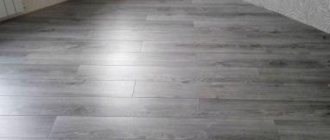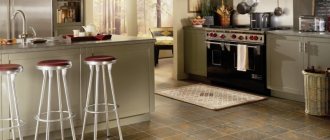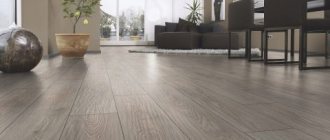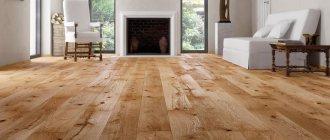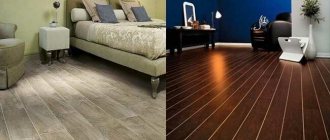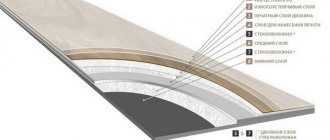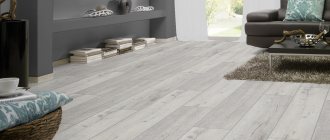New settlers and people living in the same apartment for a long time who have decided to renovate are clearly faced with the question of which flooring to choose. This is one of the most troublesome and expensive problems, when solving it it is necessary to take into account the fact that it is necessary to carry out work on laying floors that will last a long time. This wallpaper and painting are easy to change often, as soon as you are in the mood to change the design concept.
The floor is installed for many years of service, so the choice of coating is approached especially carefully, weighing all the pros and cons. They take into account the cost, service life, and methods of caring for the material. There are several types of coatings on the market: parquet, boards, laminate, linoleum and others.
Which is better: laminate or linoleum?
High-quality parquet is too expensive, and many simply cannot afford it. Boards are considered an “outdated” material with a lot of hassle - this option is practically not popular, except if an extravagant design in the “loft” style is chosen. The choice, as a rule, falls on more affordable materials: laminate and linoleum.
To make the right choice, they study the positive and negative sides of each product, and after comparing their practical advantages, make a final decision. In this article we will figure out what is better to choose – laminate or linoleum.
Both laminate and linoleum are considered fairly inexpensive materials.
Which is better: laminate or linoleum? Comparing materials
Comparative characteristics of laminate and linoleum will help you draw the right conclusions.
| № | Characteristic | Linoleum | Laminate |
| 1. | Wear resistance | It is not afraid of humidity, but is subject to external damage, is afraid of heat, and marks from furniture remain. | It has several classes of wear resistance, it does not leave marks from animal claws, sharp heels of women's shoes, or furniture, but it is deformed when exposed to moisture. |
| 2. | Installation | There are no special requirements for the floor surface, but the floor must be clean of foreign objects. Installation can be done without special training, on your own. | A flat base surface is required for installation. Correct installation should be done by an experienced professional to avoid damage to the floor, although it can be done by a less experienced person. |
| 3. | Appearance | Both materials are presented in different designs. More popular are those that imitate natural materials: any type of board, marble, granite. They are often difficult to distinguish from the real thing. | |
| 4. | Thermal insulation | A material with lower thermal and sound conductivity, especially with a fabric backing. | The product is suitable for installation on heated floors. |
| 5. | Price | High quality products, both have a comparable low cost. | |
| 6. | Care | Caring for the surface is easy - you can use any detergent. | Requires special care. Wipe the laminate only with a slightly damp cloth using special detergents. If dirt gets into the joints of the plates, they are thoroughly cleaned. Water should not get into the cracks. |
| 7. | Environmental friendliness | Linoleum contains many chemical compounds that, when released in a warm place, can negatively affect health. | Most laminate flooring is considered an environmentally friendly product that does not cause harm to humans. True, there are some species that emit substances harmful to humans when heated. |
| 8. | Flammability | Linoleum has a higher combustion class, which is indicated on the packaging as “G” and 1-1V. In this case, the chemical substances included in the composition release toxic gases during combustion, which are designated T1-T4 | Laminate does not burn, but smolders. At the same time, toxic substances are released from it, but in a smaller volume. Laminate is more fireproof. |
| 9 | Life time | Lower than laminate – 10-15 years. | Depends on the class of the selected product and the quality of installation - usually 15-30 years (with proper use). |
Each option has advantages and disadvantages, so you should choose the material taking into account your needs.
Where it is better to lay linoleum or laminate depends on the purpose of the room.
- It is better to lay linoleum in the kitchen, loggias and balconies, hallways, where there is a greater likelihood of floor abrasion and there may be high humidity.
- Laminate looks more modern, more suitable for living rooms, bedrooms, children's rooms and offices.
How does laminate differ from linoleum in terms of practical characteristics?
Laminate
These groups of floor coverings belong to synthetic finishing materials. Linoleum is supplied in rolls of different widths, laminate - in packages of 6-8 panels of compact length. Linoleum is based on PVC; a protective layer, foam base and substrate are created from this polymer. Laminate consists of 75-80% wood processing waste - an MDF or HDF board is created from it, onto which decorative paper and protective layers of synthetic resins are applied. Polymer-based adhesives are used as waste binders. A certificate will help you find out which is more harmful, but clearly the materials are in the same category for environmental safety.
Practical characteristics will help you find out the advantages of laminate over linoleum or rolled material over panels. The main ones are:
- surface requirements - manufacturers recommend laying the flooring on a flat base. Laminate more
sensitive to small changes in altitude, they can cause locks to break. Advantages on the side of linoleum; - ease of installation - it is not enough to roll out the linoleum, you need to glue it to the surface, this increases installation costs. The laminate is assembled using locking joints and can be disassembled to eliminate errors. Installers encounter problems when laying panels on the floor when they need to cut a piece of the required length from the finishing strips. To do this, use electrical equipment with special blades;
- service life - good linoleum will last 25-30 years, laminate with a similar service life will cost several times more. When comparing the characteristics of floor coverings in the middle price category, preference should be given to linoleum - this material lasts 15-20 years, laminate 5-10 years;
- ease of maintenance - reviews are divided into two equal groups: deck cleaning with a large amount of water is critical for laminate flooring, but in a house or city apartment it is not required in all rooms. Linoleum is not susceptible to impacts when heavy objects fall, but the stiletto heels of women and the claws of pets will cause irreparable damage. Cigarette marks do not appear on the laminate, but the protective layer is resistant to abrasive substances;
- thermal characteristics - it is difficult to find out what is warmer. Linoleum has a thick base made of foamed PVC, and when laying laminate, this material is necessarily used as a substrate;
- sound insulation characteristics - for external sound waves the difference is not great, but the laminate itself can become a source of extraneous sound, while linoleum absorbs the noise of footsteps well;
- transportation - linoleum with a width of three meters or more is difficult to deliver to a city apartment; compact packs of laminate are more convenient to carry.
Interesting article on the topic: Marmoleum - what is it? Characteristics and installation
Practical characteristics are slightly better than linoleum; it is a more unpretentious material with a longer service life and an affordable price.
What is better for a house and an apartment?
Many people wonder which coating is more suitable for a private home and which for an apartment. In general, both laminate and linoleum are suitable for any type of housing - they both have their advantages and disadvantages, their installation is quite simple. True, as experience shows, many people prefer to use linoleum for apartments. Why? Firstly, there is almost no noise from walking on it or moving furniture, which cannot be said about laminate flooring, especially if you walk on it in shoes. This causes discomfort to both the residents of the apartment and the neighbors below.
Secondly, linoleum is not afraid of moisture - therefore, in the event of flooding, you will not have to completely change the floor covering.
Both coatings are suitable for a private home. But the choice, of course, remains with everyone.
So, each of the presented options for budget flooring, as you can see, has both pros and cons. It is quite difficult to specifically determine which is better, since everything depends on the financial capabilities of the buyer and the purpose of the purchase. When choosing, we recommend that you rely on the quality of the material, and also take into account the specific room in which you plan to place this or that floor covering. This will allow you to choose the best option.
Useful video about choosing between laminate and linoleum
Viewed times: 5,675
Great article 1
Author's rating
Author of the article
Oleg Grishin
Flooring specialist with 10 years of experience. Oleg has something to share with our readers
Articles written
105
- Even more interesting:
- What is the difference between parquet boards and parquet
- Advantages and disadvantages of carpet
- Optimal flooring for the kitchen - how to choose it
Discussion: 2 comments
- Tom:
10/16/2018 at 11:06In general, it all depends on what room you choose flooring for. When I was thinking about what to lay in the kitchen, I didn’t even doubt that it was worth choosing linoleum, because it looks beautiful, it can be washed, and even if you spill something, linoleum, unlike laminate, will not become unusable, there will be no swelling.
Answer
- A lion:
10/19/2018 at 20:59
I also faced a choice between laminate or linoleum and ultimately chose linoleum for one simple reason. It is much easier to care for, and this is especially true for the hallway, where shoes always run off in autumn and winter, and for the kitchen, where you can litter or spill water while cooking.
Answer
Nice laminate or practical linoleum: what to choose
When choosing, you need to focus on the resistance of the material to environmental influences. You should handle laminate flooring with care if it is laid in the kitchen, since it cannot be washed frequently with a very wet cloth using chemical detergents, and if objects fall, the surface can be seriously damaged.
In bedrooms and children's rooms, it is better to give preference to laminate
For example, a knife falling with a blade onto linoleum damages the surface through and through, which significantly spoils the appearance and the resulting damage increases over time.
However, the advantage of linoleum is that it is not afraid of wet cleaning; it is strictly forbidden to pour water under the surface, which threatens the formation of mold, bumps or waves.
When carrying out repair work, you can significantly increase thermal conductivity by using a special layer.
Nuances:
- Using additional insulating substrates, the floors will be significantly warmer with any covering.
- Linoleum, thanks to a wide color palette, can be chosen to suit any interior.
- Some colors of linoleum imitate more expensive materials; the interior looks expensive and is suitable even for a rich design.
- If the floor has minor unevenness, then laminate is better suited, and if one board is damaged, it can be easily replaced with a new one.
- The linoleum will have to be changed completely, the only thing that can be done is to lay a patch and fix it with cold welding, however, the aesthetics will deteriorate greatly.
- Laminate has greater thermal conductivity than linoleum.
Related article: Italian walnut door color: interior photo
It is imperative to compare the quality of the uncoated floor with the material that can be used for this. For example, if the surface is uneven, linoleum will emphasize the unevenness, and the height peaks will be greatly abraded during use. Floor leveling may be required before installation.
Laminate or linoleum - which is better, cheaper, warmer, more environmentally friendly, more practical: expert opinion
Which of these materials is considered better? In this matter, it is worth taking into account the requirements of the selected premises. If you don't know what to choose, just compare these floor coverings based on the most important parameters.
Insulation performance:
- The thermal insulation qualities and sound insulation qualities of these two coatings are usually determined by the properties of the substrate. Which material is warmer depends on how thick the material is and what it is made of.
- Remember, if linoleum is laid, then the substrate is only an addition, the use of which is not always necessary.
- If laminate is installed, then the underlay is a mandatory element. Among the huge range of linoleum, the warmest is considered to be the type that is equipped with a compacted felt or fabric base.
- Due to its own plasticity, linoleum tends to better absorb various extraneous sounds, especially if the material has a soft base.
- If you take laminate flooring, then when you walk on it, knocking noises from shoes and hard soles will be heard throughout the apartment. However, here a good underlay can come to the rescue as sound insulation.
Advantages of laminate
Eco-friendly materials:
- Both laminate and linoleum are considered quite environmentally friendly. They are non-toxic and therefore safe. When comparing environmental friendliness, a problem often arises when disposing of linoleum, because when this material burns, it produces a strong odor and releases harmful substances.
- But, given that owners of houses and apartments do not often dispose of linoleum themselves, this drawback is insignificant.
Transportation:
- Transporting laminate flooring is much easier, since its boards are compactly packaged, and therefore the laminate can be transported in your car, even lifted using an elevator.
- Linoleum rolled into a roll has large dimensions, therefore, in order to deliver it, a truck is needed, and the roll may not even fit into an ordinary elevator for passengers.
Installation and repair:
- Installation of these materials is quite simple and in order to obtain a high quality coating, you just need to follow the instructions. If you take laminate separately, its assembly requires a responsible approach.
- Installing linoleum takes much less time compared to laying laminate, although it requires the use of special glue or double-sided tape. In addition, to lay laminate flooring you need a perfectly flat floor.
- Laminate is a more repairable material. If necessary, it is partially disassembled and some boards are replaced with others. Also, small chips or cracks on the boards can be repaired with a special repair paste.
- Linoleum is not so easily repaired. It needs to be changed all over, as it can get scratched quickly.
By choosing linoleum for laminate, you can not only save on material, but also make installation easier.
Moisture resistance:
- The main distinguishing feature of these materials is moisture resistance. Laminate does not always tolerate strong moisture, but linoleum never loses its properties when water gets on it.
- Note that today you can also find a laminate that is easily considered moisture resistant.
Special performance indicators, appearance:
- Linoleum, which is produced in rolls, does not look as presentable and does not always reliably imitate natural wood. Although in some cases the imitation works perfectly.
- If we take into account the specifics of the application, then we note that furniture and heels leave marks on the linoleum. But laminate is stronger in this regard.
- Laminate flooring can only be washed with a wet cloth, while linoleum can be washed with any available means, there are no restrictions here.
